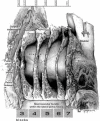A review of surgical techniques for radical prostatectomy
- PMID: 16985892
- PMCID: PMC1477597
A review of surgical techniques for radical prostatectomy
Abstract
Since the early 20th century, radical prostatectomy has been used in the treatment of prostate cancer. However, before the widespread acceptance of prostate-specific antigen screening, the majority of cancers were clinically advanced and not amenable to cure, so relatively few men were candidates for this procedure. Modern advances have contributed dramatically to the reduction of complications and morbidity associated with radical prostatectomy. As a result, the procedure has become the most common treatment selected by men with localized prostate cancer. This article reviews several issues regarding radical prostatectomy, including surgical techniques, cancer control, intraoperative localization of the cavernous nerves, patient selection, and laparoscopic versus robotic approaches.
Figures




References
-
- Young HH. The early diagnosis and radical cure of carcinoma of the prostate: being a study of 40 cases and presentation of a radical operation which was carried out in four cases. Bull Johns Hopkins Hosp. 1905;16:315. - PubMed
-
- Millin T. Retropubic Urinary Surgery. London: Livingston; 1947.
-
- Catalona WJ, Scott WW. Carcinoma of the prostate. In: Walsh PC, Gittes RF, Perlmutter AD, Stamey TA, editors. Campbell’s Urology. vol 5. Philadelphia: WB Saunders Company; 1986. pp. 1463–1534.
-
- Walsh PC, Lepor H. The role of radical prostatectomy in the management of prostatic carcinoma. Cancer. 1987;60(3 suppl):526–537. - PubMed
-
- Reiner WG, Walsh PC. An anatomical approach to the surgical management of the dorsal vein and Santorini’s plexus during radical retropubic surgery. J Urol. 1979;212:198–200. - PubMed
LinkOut - more resources
Full Text Sources
Medical
Research Materials
